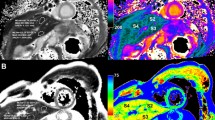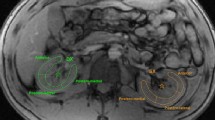Abstract
Relaxometry revealed changes in the basal ganglia in T1 and T2 relaxation times due to liver disease. Manganese is probably responsible for T1 and T2 shortening (as the concentration is known to be higher in both the liver and blood due to hepatic cirrhosis). The aim of this study was to follow possible recovery after liver transplantation by MR relaxometry. Together with a group of 20 healthy volunteers we scanned 53 patients before and after liver transplantation (some of them repeatedly). Both T1 and T2 values were evaluated in the basal ganglia, thalamus, and frontal white matter. T1, relaxation timewas shortened by approx. 20–25% compared to the control group, probably the result of manganese deposition in the brain caused by hepatic cirrhosis. After liver transplantation the relaxation time recovered gradually with almost normal values reached approx. 2 years after surgery. T1, recovery was observed in all evaluated structures. Similar results were observed with T2 relaxation in the basal ganglia and thalamus. In the white matter T2 remained low even 2 years after surgery.
Similar content being viewed by others
References
Bernthal P, Hays A, Tarter RE, Van Thiel D. Leeky J. Hegedus A. Cerebral CT scan abnormalities in cholestatic and hepatocellular disease and their relationship to neuropsychologic test performance. Hepatology 1987;7:107–14.
Moore JW, Dunk AA. Crawford JR, Deans H. Besson JAO. De Lacey G, Sinclair TS. Mowat NAG, Brunt PW. Ncuropsychological deficits and morphological MRI brain scan abnormalities in apparently healthy non-encephalopathic patients with cirrhosis. J Hepatol 1989;9:319–25.
Vymazal J, Babis M, Brooks RA. Filip K, Dezortova M, Hrn- carkova H. Hajek M. T1 and T2 alterations in the brains of patients with hepatic cirrhosis. AJNR 1996;17:333–6.
Hauser RA, Zesiewicz TA, Rosemurgy AS, Martinez C, Olanow CW. Manganese intoxication and chronic liver failure. Ann Neurol 1994;36:871–5.
Krieger D, Krieger S. Jansen O., Gass P, Theilmann L, Licht- necker H. Manganese and chronic hepatic encephalopathy. Lancet 1995:346:270–4.
Butterworth RF, Spahr L, Fontaine S, Pomier-Layrargues G. Manganese toxicity, dopaminergic dysfunction and hepatic encephalopathy. Metab Brain Dis 1995:10:259–67.
Pomier-Layrargues G, Spahr L, Butterworth RF. Increased manganese concentrations in pallidum of cirrhotic patients. Lancet 1995:345:735.
Rose C, Butterworth RF, Zayed J. Normandin L, Todd K. Michalak A, Spahr L. Huet PM. Pomier-Layrargues G. Manganese deposition in basal ganglia structures results from both portal-systemic shunting and liver dysfunction. Gastroenterology 1999:117:640–4.
Hockerstedt K, Kajaste S, Muuronen A, Raininko R, Sep- palainen AM, Hillbom M. Encephalopathy and neuropathy in end-stage liver disease before and after liver transplantation. J Hepatol 1992:16:31–7.
Ryska M, Trunecka P. Belina F, Spicak J. Peregrin J, Filip K, Vitko S. Liver transplant program in Prague. Results of consecutive first 100 orthotopic liver transplantations. Ann Transplant 2000;5:50–2.
program CHROBAK, author: Vít Herynek. Institute for Clinical and Experimental Medicine. Prague. CZ
Hajek M, Babis M, Herynek V. MR relaxometry on a whole-body imager: quality control. Magn Reson Imaging 1999;17:1087–92.
Hallgren B, Sourander P. The effect of age on the non-haemin iron in the human brain. J Neurochem 1958:3:41 51.
Schenker C, Meier D, Wichmann W, Boesiger P, Valavanis A. Age distribution and iron dependency of the T2 relaxation time in the globus pallidus and putamen. Neuroradiology 1993;35:119–24.
Kucharczyk W, Lenkinski RE, Kucharczyk J. Henkelman RM. The effect of phospholipid vesicles on the NMR relaxation of water: an explanation for the MR appearance of the neurohypophysis?. Am J Neuroradiol 1990;11:693 700.
Author information
Authors and Affiliations
Corresponding author
Rights and permissions
About this article
Cite this article
Herynek, V., Babi, M., Trune, P. et al. Chronic liver disease: relaxometry in the brain after liver transplantation. MAGMA 12, 10–15 (2001). https://doi.org/10.1007/BF02678268
Received:
Revised:
Accepted:
Issue Date:
DOI: https://doi.org/10.1007/BF02678268




